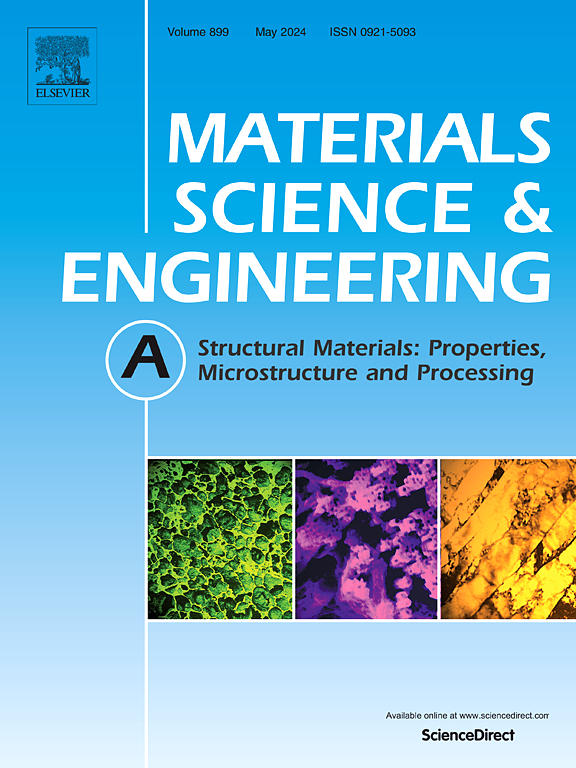Alloy design for strong and ductile Mn-alloyed Cr-Co-Ni medium-entropy alloys for room temperature applications
IF 6.1
2区 材料科学
Q1 MATERIALS SCIENCE, MULTIDISCIPLINARY
引用次数: 0
Abstract
The equiatomic Cr-Co-Ni medium-entropy alloy (MEA) is known to exhibit the highest strength and ductility among high- and medium-entropy alloys in the Cr-Mn-Fe-Co-Ni and its subset systems and many attempts have been made to further improve its strength and ductility. A new strategy for alloy design is proposed for Cr-Co-Ni-based MEA by incorporating Mn as the alloying element with the utilization of Mean-Square Atomic Displacement (MSAD) and Stacking Fault Energy (SFE) as predictors for strength and ductility. Our investigation reveals that the addition of 5 at.% Mn results in a modest reduction in MSAD and hence in 0 K yield stress, but the room temperature strength reaches the level achieved by the strongest Cr-rich Cr-Co-Ni MEA (45Cr-20Co-35Ni (in at.%) in our previous study), as the dulling of the temperature dependence of yield strength occurs below room temperature by the addition of Mn. Furthermore, at 77 K, a critical SFE value (−35 mJ/m2) is identified below which the tensile ductility drops significantly due to the change in the additional deformation mode from deformation twinning to ε-martensite transformation, while at room temperature the tensile ductility increases monotonously with decreasing SFE. The designed alloy with a composition of 40Cr-5Mn-27.5Co-27.5Ni thus achieves an optimal balance of strength and ductility at room temperature, improving the tensile ductility of the 45Cr-20Co-35Ni alloy by as much as 24 % without scarifying the yield strength.
合金设计为室温应用的坚固和延展性的锰合金铬钴镍中熵合金
等原子Cr-Co-Ni中熵合金(MEA)在Cr-Mn-Fe-Co-Ni及其亚系中高、中熵合金中表现出最高的强度和延展性,人们为进一步提高其强度和延展性进行了许多尝试。提出了一种以Mn为合金元素,利用均方原子位移(MSAD)和层错能(SFE)作为强度和延展性预测因子的cr - co - ni基MEA合金设计新策略。我们的调查显示,5的增加。% Mn导致MSAD适度降低,因此在0 K屈服应力中,但室温强度达到了最强富cr Cr-Co-Ni MEA (45Cr-20Co-35Ni (at.%))所达到的水平,因为通过添加Mn,屈服强度的温度依赖性在室温以下发生钝化。此外,在77 K时,发现了一个临界SFE值(- 35 mJ/m2),在此值以下,由于附加变形模式从变形孪晶转变为ε-马氏体转变,拉伸延性显著下降,而在室温下,拉伸延性随着SFE的降低而单调增加。因此,设计的40Cr-5Mn-27.5Co-27.5Ni合金在室温下实现了强度和延展性的最佳平衡,在不降低屈服强度的情况下,45Cr-20Co-35Ni合金的拉伸延展性提高了24%。
本文章由计算机程序翻译,如有差异,请以英文原文为准。
求助全文
约1分钟内获得全文
求助全文
来源期刊

Materials Science and Engineering: A
工程技术-材料科学:综合
CiteScore
11.50
自引率
15.60%
发文量
1811
审稿时长
31 days
期刊介绍:
Materials Science and Engineering A provides an international medium for the publication of theoretical and experimental studies related to the load-bearing capacity of materials as influenced by their basic properties, processing history, microstructure and operating environment. Appropriate submissions to Materials Science and Engineering A should include scientific and/or engineering factors which affect the microstructure - strength relationships of materials and report the changes to mechanical behavior.
 求助内容:
求助内容: 应助结果提醒方式:
应助结果提醒方式:


